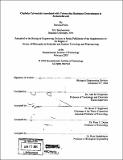| dc.contributor.advisor | John M. Essigmann. | en_US |
| dc.contributor.author | Froim, Doriana, 1973- | en_US |
| dc.contributor.other | Massachusetts Institute of Technology. Biological Engineering Division. | en_US |
| dc.date.accessioned | 2008-02-28T16:04:04Z | |
| dc.date.available | 2008-02-28T16:04:04Z | |
| dc.date.copyright | 2005 | en_US |
| dc.date.issued | 2005 | en_US |
| dc.identifier.uri | http://dspace.mit.edu/handle/1721.1/35701 | en_US |
| dc.identifier.uri | http://hdl.handle.net/1721.1/35701 | |
| dc.description | Thesis (Ph. D. in Molecular and Systems Toxicology and Pharmacology)--Massachusetts Institute of Technology, Biological Engineering Division, 2005. | en_US |
| dc.description | Includes bibliographical references. | en_US |
| dc.description.abstract | Tetracyclines, a broad-spectrum class of antibiotics, were discovered in the late 1940s, and became widely used because of their important advantages: they are inexpensive, safe, demonstrate good oral absorption, and are active against a broad range of bacterial pathogens. Unfortunately, as with most antibiotics, the emergence of microbial resistance to tetracyclines has become a serious problem. Today, most genera examined have tetracycline-resistant isolates, although the percentage varies according to species and geographic location. Due to the emergence of resistance, tetracyclines are no longer the antibiotics of choice in treatment of many conditions, although they are still extensively used to treat a variety of bacterial infections. Substantial research efforts have been directed towards reversing tetracycline resistance in bacteria. This work describes the development of a novel anti-bacterial treatment for diseases caused by bacteria resistant to tetracycline. It was found that tetracycline-resistant bacteria expressing the TnlO gene of tetracycline resistance, upon induction with tetracycline, became extremely susceptible to destruction by the DNA-damaging anti-cancer drug cisplatin. Tetracycline-resistant bacteria grown in tetracycline and subsequently treated with cisplatin in the presence of tetracycline were killed about 10⁵-fold more effectively than wild-type bacteria and tetracycline-resistant bacteria not exposed to tetracycline. This phenomenon was observed in different strains of tetracycline-resistant E. coli. Other antibiotics tested with respective antibiotic-resistant bacteria did not produce the same effect of sensitization to cisplatin, suggesting a unique relationship among cisplatin, tetracycline and the tetracycline resistance | en_US |
| dc.description.abstract | (cont.) gene. It was determined that levels of platinum DNA damage were higher in sensitized tetracycline-resistant cells than in wild-type cells, although total cellular platinum levels in sensitized tetracycline-resistant cells were not increased. At this time, the mechanism of increased DNA damage formation and the mechanism underlying sensitization to cisplatin are still matters of speculation. The experiments reported here, however, demonstrate that cells expressing the genes of tetracycline resistance actually became primary targets for destruction by cisplatin. Based on this study, it is suggested that the therapeutic power of the tetracyclines could be restored and enhanced by using a complementary drug that, in combination with tetracycline, would induce selective destruction of tetracycline-resistant bacteria. | en_US |
| dc.description.statementofresponsibility | by Doriana Froim. | en_US |
| dc.format.extent | 97 leaves | en_US |
| dc.language.iso | eng | en_US |
| dc.publisher | Massachusetts Institute of Technology | en_US |
| dc.rights | MIT theses are protected by copyright. They may be viewed, downloaded, or printed from this source but further reproduction or distribution in any format is prohibited without written permission. | en_US |
| dc.rights.uri | http://dspace.mit.edu/handle/1721.1/35701 | en_US |
| dc.rights.uri | http://dspace.mit.edu/handle/1721.1/7582 | |
| dc.subject | Biological Engineering Division. | en_US |
| dc.title | Cisplatin cytotoxicity associated with tetracycline resistance determinants in Escherichia coli | en_US |
| dc.type | Thesis | en_US |
| dc.description.degree | Ph.D.in Molecular and Systems Toxicology and Pharmacology | en_US |
| dc.contributor.department | Massachusetts Institute of Technology. Department of Biological Engineering | |
| dc.identifier.oclc | 60504264 | en_US |
